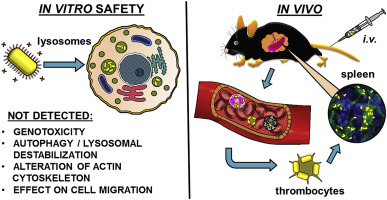当前位置:
X-MOL 学术
›
Biomaterials
›
论文详情
Our official English website, www.x-mol.net, welcomes your
feedback! (Note: you will need to create a separate account there.)
Biological safety and tissue distribution of (16-mercaptohexadecyl)trimethylammonium bromide-modified cationic gold nanorods.
Biomaterials ( IF 12.8 ) Pub Date : 2017-11-01 , DOI: 10.1016/j.biomaterials.2017.10.044 Monika Zarska 1 , Michal Sramek 1 , Filip Novotny 2 , Filip Havel 2 , Andrea Babelova 3 , Blanka Mrazkova 1 , Oldrich Benada 4 , Milan Reinis 5 , Ivan Stepanek 5 , Kamil Musilek 6 , Jiri Bartek 7 , Monika Ursinyova 8 , Ondrej Novak 9 , Rastislav Dzijak 1 , Kamil Kuca 6 , Jan Proska 10 , Zdenek Hodny 1
Biomaterials ( IF 12.8 ) Pub Date : 2017-11-01 , DOI: 10.1016/j.biomaterials.2017.10.044 Monika Zarska 1 , Michal Sramek 1 , Filip Novotny 2 , Filip Havel 2 , Andrea Babelova 3 , Blanka Mrazkova 1 , Oldrich Benada 4 , Milan Reinis 5 , Ivan Stepanek 5 , Kamil Musilek 6 , Jiri Bartek 7 , Monika Ursinyova 8 , Ondrej Novak 9 , Rastislav Dzijak 1 , Kamil Kuca 6 , Jan Proska 10 , Zdenek Hodny 1
Affiliation

|
The exceptionally high cellular uptake of gold nanorods (GNRs) bearing cationic surfactants makes them a promising tool for biomedical applications. Given the known specific toxic and stress effects of some preparations of cationic nanoparticles, the purpose of this study was to evaluate, in an in vitro and in vivo in mouse, the potential harmful effects of GNRs coated with (16-mercaptohexadecyl)trimethylammonium bromide (MTABGNRs). Interestingly, even after cellular accumulation of high amounts of MTABGNRs sufficient for induction of photothermal effect, no genotoxicity (even after longer-term accumulation), induction of autophagy, destabilization of lysosomes (dominant organelles of their cellular destination), alterations of actin cytoskeleton, or in cell migration could be detected in vitro. In vivo, after intravenous administration, the majority of GNRs accumulated in mouse spleen followed by lungs and liver. Microscopic examination of the blood and spleen showed that GNRs interacted with white blood cells (mononuclear and polymorphonuclear leukocytes) and thrombocytes, and were delivered to the spleen red pulp mainly as GNR-thrombocyte complexes. Importantly, no acute toxic effects of MTABGNRs administered as 10 or 50 μg of gold per mice, as well as no pathological changes after their high accumulation in the spleen were observed, indicating good tolerance of MTABGNRs by living systems.
中文翻译:

(16-巯基十六烷基)三甲基溴化铵修饰的阳离子金纳米棒的生物安全性和组织分布。
带有阳离子表面活性剂的金纳米棒(GNR)的细胞吸收异常高,使其成为生物医学应用的有前途的工具。鉴于某些阳离子纳米粒子制剂的已知特定毒性和应激作用,本研究的目的是在小鼠体内和体外评估涂有(16-巯基十六烷基)三甲基溴化铵的GNR的潜在有害作用(MTAB GNR)。有趣的是,即使在细胞积累大量MTAB之后可以在体外检测到足以诱导光热效应,无遗传毒性(即使长期积累后),自噬诱导,溶酶体失稳(其细胞目的地的主要细胞器),肌动蛋白细胞骨架改变或细胞迁移的GNR 。在体内,静脉内给药后,大部分GNR积累在小鼠脾脏中,其次是肺和肝。血液和脾脏的显微镜检查显示,GNRs与白细胞(单核和多形核白细胞)和血小板细胞相互作用,并主要作为GNR-血小板复合物递送至脾红髓。重要的是,没有MTAB的急性毒性作用每只小鼠以10或50μg金的形式施用GNR,并且未观察到它们在脾脏中高积累后的病理变化,这表明活体系统对MTAB GNR具有良好的耐受性。
更新日期:2017-11-01
中文翻译:

(16-巯基十六烷基)三甲基溴化铵修饰的阳离子金纳米棒的生物安全性和组织分布。
带有阳离子表面活性剂的金纳米棒(GNR)的细胞吸收异常高,使其成为生物医学应用的有前途的工具。鉴于某些阳离子纳米粒子制剂的已知特定毒性和应激作用,本研究的目的是在小鼠体内和体外评估涂有(16-巯基十六烷基)三甲基溴化铵的GNR的潜在有害作用(MTAB GNR)。有趣的是,即使在细胞积累大量MTAB之后可以在体外检测到足以诱导光热效应,无遗传毒性(即使长期积累后),自噬诱导,溶酶体失稳(其细胞目的地的主要细胞器),肌动蛋白细胞骨架改变或细胞迁移的GNR 。在体内,静脉内给药后,大部分GNR积累在小鼠脾脏中,其次是肺和肝。血液和脾脏的显微镜检查显示,GNRs与白细胞(单核和多形核白细胞)和血小板细胞相互作用,并主要作为GNR-血小板复合物递送至脾红髓。重要的是,没有MTAB的急性毒性作用每只小鼠以10或50μg金的形式施用GNR,并且未观察到它们在脾脏中高积累后的病理变化,这表明活体系统对MTAB GNR具有良好的耐受性。











































 京公网安备 11010802027423号
京公网安备 11010802027423号